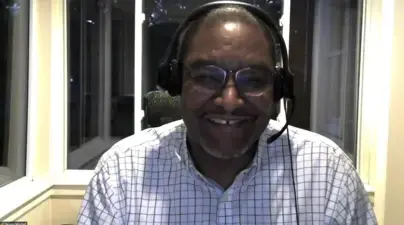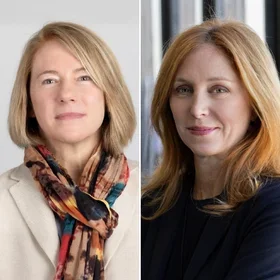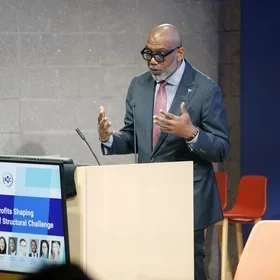Dr. Robert Sellers, Vice Provost for Equity and Inclusion, Chief Diversity Officer, and Charles D. Moody Collegiate Professor of Psychology and Education at the University of Michigan, and Dr. Dennis Mitchell, Vice Provost for Faculty Advancement and Professor of Dental Medicine at Columbia University, spoke to Human Capital Management students in Dr. Edna Chun’s Effective Partnership Strategies course earlier this fall.
On October 6, Dr. Sellers guest-lectured for the course to discuss stakeholder engagement. Dr. Sellers is a national thought leader on diversity and inclusion. He engaged actively with the class and explained that despite the development of a number of diversity programs and student activism over a period of years, University of Michigan (UM) had never really had a formal, university-wide strategic plan for diversity. That changed, however, in 2014 with the appointment of a new university president and his own appointment as Chief Diversity Officer (CDO). UM is now in the fourth year of their plan for diversity. Below is an outline of the key points in Dr. Sellers's lecture:

1. The goal of the UM strategic diversity plan was simply institutional cultural change that is long-lasting and responsive, rather than reactive. The plan sought to promote stakeholder engagement and is tied to the mission of the university.
2. The goal of the diversity strategic planning process was for Diversity, Equality and Inclusion (DEI) to be part of the university’s DNA and operational processes and not a contested value. He explained that this has actually taken place at UM where the value of diversity is no longer questioned.
3. It was important to define terms and link to the university’s mission. Diversity is often defined narrowly in terms of race/ethnicity, gender or other demographic characteristics. Dr. Sellers related the difference of the individual terms of DEI in relation to a party: diversity is like being invited to the party, equity is like being invited to dance at that party and inclusion is like everyone contributing a song to the playlist for the party. This can mean disrupting traditional forms of power in order for everyone to have an opportunity to contribute and have ownership in the university.
4. The plan was designed to move to action: policies, procedures, behaviors, interactions. As a result, DEI is part of hiring practices and the annual budgeting process. DEI is embedded throughout all the budget documents. Unit progress on DEI is part of the budgetary evaluation and allocation process for academic and administrative units.
5. UM has agreed to move to DEI 2.0 after the fifth year of the plan and take another year to plan further. It is similar to the capital campaign in this sense.
In summary, as Dr. Sellers explained, “We have to work to be more equitable since diversity leads to better problem solving, leads to more creative solutions and ultimately more successful solutions.” And, he added, “We always want to connect diversity to issues of equity and inclusion. Diversity in not-inclusive spaces also leads to less positive perceptions of climate. That doesn’t get us to really excelling as an institution and a better education strategy.”
Among the students' comments were, “Loved hearing from Dr. Sellers—super informative! He is a great speaker and has a lot to offer.”
On October 13, Dr. Mitchell was the guest speaker for the class. He discussed the role of vision and mission in Columbia’s strategic diversity initiatives, and explained that due to the vision of President Lee Bollinger who came to Columbia in 2002, Columbia has catapulted to a national leadership position in faculty diversity recruitment and retention. He also described Lee Bollinger’s involvement in the pivotal Supreme Court cases: 2003 Grutter v. Bollinger and Gratz v. Bollinger, which reaffirmed the educational benefits of diversity on college campuses. Below is an outline of the key points in Dr. Mitchell's lecture:

1. Dr. Mitchell highlighted Columbia’s vision and aspiration for inclusive excellence as “the go-to place for the world’s greatest scholars.” The vision specifically states that Columbia “cannot achieve this aspiration without realizing our core values of inclusion and excellence.”
2. In 2003, there were few black faculty at Columbia and over a period of more than a decade, investments were made in Arts and Sciences, professional schools and then in the university at large. Investments of more than $185 million have been made since 2005 and resulted in 94 new faculty hires.
3. The events of May 25 with the killing of George Floyd and the protests of the Black Lives Matter movement coupled with the global pandemic have caused a pivot and put the spotlight on racial diversity. Dr. Mitchell warned that because the spotlight on diversity has shifted over time, it is critical to put programs in place that are sustainable even after the spotlight moves again.
4. Following the nationwide protests, the Vice Provost’s office began conversations in a program entitled “Addressing Racism: A Call to Action for Higher Education.” Seed grants for systemic change toward racial equity were offered in summer 2020 and 58 applications were received and funded. The School of Social Work’s course called PROP (Power, Racism, Opportunity and Privilege) was the basis for a mini-institute on addressing anti-black bias. The program was offered to faculty in summer 2020 and will be provided to the university’s leadership over the next month. Dr. Mitchell emphasized that these conversations are difficult, but indicated that discomfort is the only way that we can initiate the necessary healing process.
5. In response to questions from the class, Dr. Mitchell emphasized that resources for diversity need to focus on three separate areas: climate, recruitment and community. He emphasized that climate affects retention, a sense of belonging and the ability to thrive, including opportunities for advancement.
Learn more about the M.S. in Human Capital Management program.


